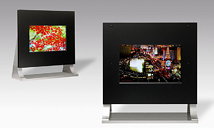malware
New Member
- Joined
- Nov 7, 2004
- Messages
- 5,422 (0.72/day)
- Location
- Bulgaria
| Processor | Intel Core 2 Quad Q6600 G0 VID: 1.2125 |
|---|---|
| Motherboard | GIGABYTE GA-P35-DS3P rev.2.0 |
| Cooling | Thermalright Ultra-120 eXtreme + Noctua NF-S12 Fan |
| Memory | 4x1 GB PQI DDR2 PC2-6400 |
| Video Card(s) | Colorful iGame Radeon HD 4890 1 GB GDDR5 |
| Storage | 2x 500 GB Seagate Barracuda 7200.11 32 MB RAID0 |
| Display(s) | BenQ G2400W 24-inch WideScreen LCD |
| Case | Cooler Master COSMOS RC-1000 (sold), Cooler Master HAF-932 (delivered) |
| Audio Device(s) | Creative X-Fi XtremeMusic + Logitech Z-5500 Digital THX |
| Power Supply | Chieftec CFT-1000G-DF 1kW |
| Software | Laptop: Lenovo 3000 N200 C2DT2310/3GB/120GB/GF7300/15.4"/Razer |
Toshiba Matsushita Display (TMD) has developed the world's largest 20.8-inch low-temperature poly-silicon (LTPS) organic light-emitting diode (OLED) display panel to advance to the next-generation of flat-screen TV sets and monitors. The new 20.8-inch OLED display has been developed based on LTPS technology, which TMD has been continually refining, and an electroluminescent coating process, which is advantageous for larger display screen sizes. The three (RGB) color-emitting layers use polymer organic electroluminescent materials, and an ink-jet type coating process is adopted for coating of each color. These have contributed to achieving a large screen size of 20.8-inch and would enable the expansion of potential applications of large-size OLED panels, which have been conventionally limited to smaller size screens. The newly developed panel will be exhibited in TMD's booth at the 3rd International FPD Expo (Display 2007) at Tokyo Big Sight from April 11 through April 13, 2007.

View at TechPowerUp Main Site

View at TechPowerUp Main Site







